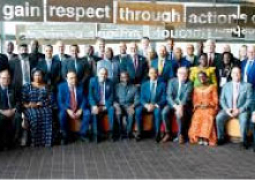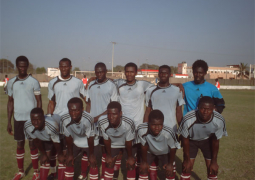In a series of weekly articles starting today, Mr. Ebraima Manneh, gives an overview of the defunct Senegalo Gambia Permanent Secretariat, an organisation linking Senegal and the Gambia in a cooperative arrangement which was dissolved in 1988 following the creation of the Senegambian Confederation
In light of the recent standoff at the borders between Senegal and the Gambia involving Senegalese transport operatives, one cannot but remember the Secretariat whose vocation it was, among other things, to act as motor for settling problems like the present one. Mr. Manneh worked for six years as the most senior Gambian official in the Secretariat up to the time of its dissolution, as Assistant to the Executive Secretary.
As Director of Economic and Technical Affairs, he was responsible for inter state transport.
Introduction
On the acquisition of independence by the Gambia in 1965, five years after Senegal’s independence, a proposal in the United Nations report looking at the future of the newly independent Gambia and possible relations with its bigger neighbour Senegal of forming a Union of the two countries was not accepted by the Gambia government. Instead a loose Treaty of Association was signed between the two countries in 1965. This agreement outlined the areas of cooperation between the two countries and created a Permanent Secretariat responsible for the implementation of the Agreement.
It was agreed that the Permanent Secretariat would be based in Banjul and the head of the organisation – the Executive Secretary to be appointed by the two countries, would be provided by Senegal and by tacit agreement, his second in command would be a Gambian. The Secretariat, being an inter governmental organisation, had the status of a diplomatic mission. Its office was located opposite Atlantic hotel on Marina Parade, in one of the imposing colonial buildings that used to serve as residences of the colonial officials.
The first Executive Secretary was Mr Seydina Oumar Sy. He was succeeded by Mr Ibra Degene Ka, followed by Mr Seydou Nourrou Ba and finally Mr. Pierre Diouf . For the Gambian deputies, who occupied the post of Director of Economic and Technical Affairs, Mr. Hatib Janneh was the first, followed by Bakary Darboe, Ebou Taal, Hassum Ceesay, Ousman Othman, Omadi Diarra and Ebraima Manneh.
Their counterparts, occupying the post of director of Cultural and Educationaal matters, were Laurent Diatta, Djiby Sall, Kaderr Seck, Djibril Macodou Fall. In all cases all seconded Senegalese and Gambian officials at that level were senior civil servants from the respective administrative services. Such was the experience gained that after leaving the secretariat they were promoted to ranks of Ambassador or Permanent Secretary. Other officials who served in the Secretariat were Momodou Mbota Njie (Accountant), Njoggou Bah, Jean Baptiste Kane, Pa Gaye, Mrs Sainabou Njie Jagne, to name a few.
Pierre Diouf for some six years played a dual role of Executive Secretary of the Senegalo Gambian Permanent Secretariat on the one hand and Secretary General of the Secretariat of the Senegambian Secretariat based in Dakar to service the Senegambian Confederation on the other.
Naturally, with the fledgling Confederal Secretariat Mr Diouf was based more in Dakar running that Secretariat beside the President Abdou Diouf, President of the Confederation than in Banjul.
The vocation of the Secretariat was based on the provisions of the Treaty of Association signed by the two countries in 1995. The details of this Treaty wil be examined in subsequent articles.
In practice, the Secretariat became the embodiment of the desire and will of the two governments to ensure the smooth maintenance of friendly sisterly relations between the Gambia and Senegal. The idea was to maintain constant consultations on matters that affect or may affect, the two countries, through bilateral meetings of officials and in some cases Ministers and even Heads of State. This way, problems that have the potential of creating conflict or misunderstanding are "nipped at the bud".
Secondly, was charged with ensuring that the two countries implement the provisions of this Treaty and subsequent ones and in some cases acted as catylist of programmes and projects of common interest to the two countries. Consequently, joint cooperation to fight common problems e g. mutual assistance in customs matters was initiated. Initially a cooperation Agreement was signed between the two countries and later extended to include Guinea Bissau. Some 45 Joint Agreements in all were signed between the two countries in various key fields ranging from Defence to New and renewable Energy. In subsequent articles these Agreements will be discussed in detail.
Thirdly, cooperation in development eg the Gambia River Basin Development which was the precursor of the Gambia River Basin Development Organisation (OMVG) which later integrated the other countries through which the River Gambia runs – Guinea Conakry and Guinea Bissau.
The Dakar Banjul Bissau Regional Road project and the tele communications link Dakar Banjul Bissau are also other projects that concretised the cooperation between the two states and brought in other States outside the Senegambian area.
The Permanent Secretariat was lightly staffed, compared to the Confederal Secretariat or other inter governmental organisations. It was headed by a Senegalese Chief Executive Officer – the Executive Secretary. Apart from this post, nearly all of the other posts had counterparts - two Directors – one Gambian responsible for Economic and Technical affairs and the other of Senegalese nationality responsible for Cultural and Educational matters.
These were followed by two Translators – one Gambia and one Senegalese a Gambian Accountant, an Archivist and Private Secretary. Three drivers, two messangers.
The obligations of the two countries were as follows:
The Senegalese government paid two thirds of the Secretariat's budget and nominated for appointment the Executive Secretary, the Director of Cultural and Educational Affairs and the French language interpreter. It accorded full diplomatic priviledges in Senegal
The Gambian government paid one third of the budget of the Secretariat, provided the headquarters of the Secretariat and the residence of the Executive Secretary. It accorded the Secretariat full diplomatic status in The Gambia
In the two countries, the Secretariat worked directly with the various Ministries and Departments whose work is covered by one of the Joint Agreements coordinated by the Secretariat. Invariably most Departments and Ministries are involved. However the host Ministry was the Ministry of Foreign Affairs under whos purview the Secretariat falls.
The Secretariat worked in these ways:
Coordination of the Joint Agreements - 43 of them – signed between the Gambia and Senegal covering various fields of government activity
Organising periodic meetings, usually once a year, bringing together experts in the specific field covered by a particular Joint Agreement.
Ensuring the implementation of agreements and decisions arrived at in meetings of the two parties.
Acting as impulsion and propulsion of joint projects and programmes to be implemented in the two countries.
Monitoring of timely implementation of decisions taken at periodic meetings.
Acting as plaque tournante or cog for assistance from donors and collaborating agencies in regard to joint projects for which international funding was necessary (for example funding from the European Economic Community, now European Union, for the Dakar Banjul Bissau Regional Road Project.
Initiating meetings to discuss matters that my engender conflict between the two countries and even third countries.
This is particularly the case with customs matters, road transport (including ferries), and demarcation of borders.
Organisation of joint campaigns in regard to imminent danger of an agricultural or public health nature – locust or caterpillar invasion of meningitis outbreak etc
Organisation of friendly encounters like football matches, draught competitions between officials of specific services eg Customs and the police, and sports championships between youth groups of the two countries
All these facilitated the smooth maintenance of cordial relations between the two sister countries condemned to live together by history, language, ethnicity, religion and culture.
The Senegalo Gambian Permanent Secretariat was geared towards greasing this relationship and reducing to the bare minimum the areas of possible conflict and enhancing the areas that they share in common.
In the articles that follow, the Joint Agreements signed between Gambia and Senegal will be looked at in detail giving their effectiveness in solving problems and encouraging cooperation and fraternal co existence.
To be continued



